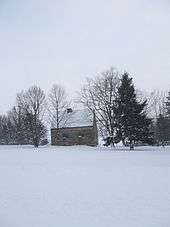Hans Herr
Hans Herr (September 17, 1639 – October 11, 1725) was born in Zürich, Switzerland, a descendant of the Knight, Hugo Herr. He joined the Swiss Brethren (later called Mennonites) and became a bishop. He was the first Mennonite bishop to emigrate to America.

When religious persecution became unendurable in Switzerland, many of his congregation emigrated with him to the Electorate of the Palatinate in Germany, which was governed by a ruler who promised them protection and religious freedom. This was satisfactory until the Palatinate fell into the hands of other rulers, subjecting the Mennonites to severe religious persecution once again.
When this occurred, a number of them visited William Penn in London, in 1707, and arranged terms with him to colonize a portion of what is now Lancaster County, near what was then the western frontier of Pennsylvania. In 1709, Hans Herr, John R. Bundely, Martin Meylin (Mylin), Martin Kendig, Jacob Miller, Hans Funk, Hans Graff (Groff), Martin Oberholtzer, Wendel Bowman and others bought 10,000 acres (40 km²) of land on the south side of Pequea Creek. A warrant was issued for the land October 10, 1710, and it was surveyed October 23, 1710.[1]
The tradition (which has never been disproved) is that these immigrants held a conference as to what steps should be taken to inform their relatives and friends in Europe of their opinions and expectations of their new lands, and it was determined that Hans Herr, their revered minister, should return, explain the situation and the great advantages of emigration, and bring with him those he could induce to come. He sailed to Europe and returned to America with many more immigrants, despite making the journey at 70 years old. He had six sons.
House and museum
The Hans Herr House, built by his son Christian Herr in 1719, is open to the public as a museum, and is the oldest Pennsylvania German settlement still in existence today. The house is located at 1849 Hans Herr Drive in Willow Street, Pennsylvania.
The museum complex includes the 1719 Hans Herr House, the Georgian-style 1835 Shaub House, the Victorian-style 1890s Huber House, several barns and outbuildings with animals, exhibit buildings, blacksmith shop, bake-oven, smoke house, and a collection of farm equipment. Exhibits focus on Mennonite history, colonial and Victorian era farm life, and the Herr family. The museum opened in 1974 and is administered by the Hans Herr House Foundation.
References
- ↑ Herr, Theodore (1908). Genealogical Record of Hans Herr. Lancaster Mennonite Historical Society. pp. ix–xi.